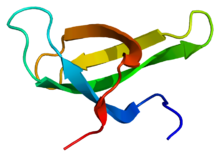Survival of motor neuron
| Survival motor neuron protein | |||||||||
|---|---|---|---|---|---|---|---|---|---|

Tudor domain from human SMN. PDB 1g5v
|
|||||||||
| Identifiers | |||||||||
| Symbol | SMN | ||||||||
| Pfam | PF06003 | ||||||||
| Pfam clan | CL0049 | ||||||||
| InterPro | IPR010304 | ||||||||
| SCOP | 1mhn | ||||||||
| SUPERFAMILY | 1mhn | ||||||||
|
|||||||||
| Available protein structures: | |
|---|---|
| Pfam | structures |
| PDB | RCSB PDB; PDBe; PDBj |
| PDBsum | structure summary |
Survival of motor neuron or survival motor neuron (SMN) is a protein that in humans is encoded by the SMN1 and SMN2 genes.
SMN is found in the cytoplasm of all animal cells and also in the nuclear gems. It functions in transcriptional regulation, telomerase regeneration and cellular trafficking. SMN deficiency, primarily due to mutations in SMN1, results in widespread splicing defects, especially in spinal motor neurons, and is one cause of spinal muscular atrophy. Research also showed a possible role of SMN in neuronal migration and/or differentiation.
SMN is evolutionarily conserved including the Fungi kingdom, though only fungal organisms with a great number of introns have the Smn gene (or the splicing factor spf30 paralogue). Surprisingly, these are filamentous fungus which have mycelia, so suggesting analogy to the neuronal axons.
SMN complex refers to the entire multi-protein complex involved in the assembly of snRNPs, the essential components of spliceosomal machinery. The complex, apart from the "proper" survival of motor neuron protein, includes at least six other proteins ()
...
Wikipedia
